
USA/TC official photograph (Photo: R. Tourret Collection)
History of the
ALCO-GE 127 ton DIESEL LOCOMOTIVES RSD-1
(USA/TC 8000-56 & 8600-99)

USA/TC official photograph (Photo: R. Tourret Collection)
This design of locomotive originated from a Bo-Bo shunting engine which went into service in 1938. This was developed into a mixed-traffic design which first went into service in 1942. Some of these engines were ordered for service in the United States (USA/TC 7122-5 and 8932-9, for instance) and these had fourwheeled bogies. For overseas service in areas where the axle-loading was considered likely to be limited, six-wheel bogies were fitted. It is these six-wheel bogie locomotives that this Chapter deals with.
The welded underframe was carried on two bogies, each carrying two nose-suspended traction motors. The six-wheeled bogies were similar to the four-wheeled ones except for the addition of an extra axle. In the front were situated the radiators and main fan, followed by the engine-generator set and then the driving cab which was sited to the rear of the locomotive followed only by the housing behind the cab for the heating boiler and accessories if fitted. A 1000hp Alco series 539 six-cylinder four-stroke supercharged diesel engine drove, besides auxiliaries, the main generator which supplied current to the electric traction motors.
The first series, USA/TC 8000-12, carried miscellaneous maker's numbers and were originally 0-4-4-0DE (RS-1) built for the following lines;
(*) NYS&W got postwar RS-1s with the same road numbers.
These locomotives were probably delivered in early 1942 and taken over by the USA/TC about October 1942. They were rebuilt from 0-4-4-ODE to 0-6-6-ODE with new bogies in the United States and renumbered into the USA/TC series. Further locomotives were built specially for the USA/TC, 8013-56 being Order No S-1898 of 1942, which also covered the early rebogied units. All were Alco class 606-DL-254. USA/TC 8600-99 were Order No S-1952 of 1944.
The Alco works numbers were as follows:
| USA/TC # | work number | delivery | Original destination |
| 800011 8002/3 8004 8005/6 8007 8008 8009 8010/1 8012 |
69992/3 69567/8 69570 69424/5 69569 69428 69566 69426/7 69800 |
1942 1942 1942 1942 1942 1942 1942 1942 1942 |
New York, Susquehanna & Western Railroad 231/3 Chicago, Milwaukee, St Paul & Pacific Railroad 1678/9 Chicago, Rock Island & Pacific Railroad 747 Chicago, Rock Island & Pacific Railroad 748/9 Chicago, Rock Island & Pacific Railroad 746 Tennessee Coal & Iron Railroad Co 600 Tennessee Coal & Iron Railroad Co 601 Atlanta & St Andrews Bay Railroad 901-2 Atlanta & St Andrews Bay Railroad 903 |
| 8013-33 8034-56 |
70634-54 70655-77 |
1942 1943 |
Built directly for USA/TC |
| 8600-38 8639-49 |
72073-111 72112-22 |
1944 1945 |
Built for Russia |
| 8650-79 | 72143-72 | 1945 | Built for Europe |
| 8680-99 | 72123-42 | 1945 | Built for Russia |
 USA/TC 8015 at Stockton in California in 1948 (Photo: H.L. Goldsmith)
USA/TC 8015 at Stockton in California in 1948 (Photo: H.L. Goldsmith)
The Trans-Iranian Railway
In October 1942 it was decided that American personnel should take over the operation of the Trans-Iranian Railway in 1943 as far north as Teheran. At this time the American Mikados (WD/USA series 1000-1199) had just started working in Iran, although it was realised that the extreme temperatures in the southern plains and above all the scarcity of good water along the whole fine made the operation of heavy trains by steam locomotives extremely difficult. Moreover, the 1000ton "Aid-to-Russia" trains required double-heading over the mountain sections, where gradients of 1 in 67 were frequent and the fact that there were 144 tunnels in 165 miles meant that locomotive crews suffered considerable hardship from smoke and oil fumes.
Accordingly, it was decided to send some of the 1000hp diesel-electric locomotives to work the worst sections of this fine, and to suit the 67 to 75lb/yd rails in Iran six-wheeled bogies were used. USA/TC 8000-12 arrived about March 1943, and were normally used singly on the eomparatively lever fines in the southern plains, hauling goods and passenger trains between Ahwaz and Bandar Shalpur, Khorramshahr, Tanuma and Andhimishk. Later, when the second batch came, some were used further north.
The second batch, USA/TC 8013-56, were fitted for multiple-unit working so that two locomotives could be worked with only one engine crew. They arrived in April 1943. They were stationed at Andhimishk and Arak, and normally worked in pairs hauling all the heavy northbound freight trains over the mountainous sections between these two places. On the return journey, as many as five were coupled together to work back to Andhimishk. In May 1943, the situation was that USA/TC 8007/9-12/28/9/31/4-56 were not erected, 8000-5/13/5/8/30 were allocated to the southern Division and 8006/8/14/6/7/9-27/32/3 were allocated to the Andhimishk-Arak pool. From September 1943, some of them worked as far north as Qum and by May 1944 some were working regularly through to Teheran. Between Arak and Teheran it became a common sight to see a diesel and a USA/TC steam 2-8-2 coupled together at the head of a train, and on at least one occasion two diesels and a 2-8-2 were used on a passenger train.
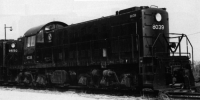 Picture of No 8039, a non requisitioned RSD-1
Picture of No 8039, a non requisitioned RSD-1
Russian order
The Soviet government was impressed with the performance of these Alco 127 ton units in Iran and requested 70 for use in Russia. Accordingly, USA/TC 8600-49/80-99 were built with 5ft 0in gauge bogies for Russia, the last twenty being built before the ones destined for Europe. USA/TC 8621/6/30-49 were landed in Great Britain before transhipment to Russia via the Arctic convoys. USA/TC 8630-40/9 were lost en route. They became Russian SZD Class Da20-1 to 58, presumably standing for "Diesel, American". Russia wanted more of these locomotives in 1946, but this was now politically impossible so the Russians built a copy as their Class TE-1 (except for the cab). Several hundred were built between 1947 and 1950. TEM-1, TEM-2 and TEM-2A were similar types built during the 1960s, and these led to further developments as classes TEM-7 and TEM-12 over the years.
USA/TC 8605, USSR Da 20.6, bound for Russia, official photograph (Photo: R. Tourret Collection)Some Da 20 class locomotives are still in service today (1991), and are even receiving new "computor" numbers.
In Iran, the heavy "Aid-to-Russia" traffic had terminated by May 1945 and the 0-6-6-ODEs were crated at Ahwaz and shipped back to the United States in June and July 1945, where they were sent to Fort Holabird Military Railway Shop for a thorough overhaul. Most were then sent to New Cumberland Army Depot near Harrisburg, Pa, and placed in store. Three units, USA/TC 8014-6, were sent to the Tonopah and Goldfield to serve an Army Air Force Field in the desert. In 1948/9, USA/TC 8021 (together with a similar unit) was tried on the Churchill (Hudson bay) fine, operated by the Canadian National Railway, for cold weather testing, but was extensively damaged by a fire.
An European chapter
Later diesels of this type, USA/TC 8650-79, were sent to Europe around May and June 1945. They were not used much. USA/TC 8650/3/60/2/4/5/70/1 were noted stored at Brussels Forest Midi shed in July 1945. They were all returned to the USA in 1946.
 USA/TC 8669 at Cedar Hill Yard, New Haven, in september
1955 (Photo: H.L. Goldsmith) USA/TC 8669 at Cedar Hill Yard, New Haven, in september
1955 (Photo: H.L. Goldsmith) |
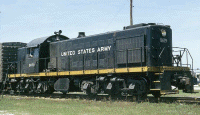 US Army RSD-1 8679 at Fort Bragg NC, May
74 (Dave Goss Photo) US Army RSD-1 8679 at Fort Bragg NC, May
74 (Dave Goss Photo) |
Alaska Railroad History
Thirty-six of the Iranian 80XX series, as well as USA/TC 8650/64, went to the Alaska Railroad and were renumbered in their 10XX series. Twenty-eight of these diesels were sold to and went to Alaska in small batches, the first of these is believed to have been a group of nine which reached Alaska in mid-1946, while 8005/19/20/3 arrived in September 1950 and are believed to have been either the last or last but one batch. Certainly, all arrived before January 1951. Another eight were leased by the ARR and arrived between March and July 1951. While the USA/TC were releasing these locomotives, the Alaska Railroad obtained some new engines, and it appears that the two series of engines were numbered in order of delivery to the ARR.
Details of the renumbering of the 42 ex-USA/TC locomotives:
|
|
||||||||||||||||||||||||||||||||||||||||||||||||||||||||||||||||||||||||||||||||||||||||||||||||||||||||||||||||||||||||||
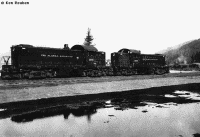 The Alaska Railroad found that the open-type or
tight-fitting hood over the engine of the ex-military 1ocomotives was not very good for
maintenance in the subzero weather sometimes experienced, and a programme was started to
rebuild their own locomotives into shrouded units. The leased locomotives, ARR
1032-6/41-3, were not so treated, however. The rebuilt locomotives either had a cab and
were termed "A" units or were without a cab and were known as "B" or
booster units. At the same time, units without multiple-unit control were so fitted and
the six-wheel bogies were interchanged for roller-bearing four-wheel units (except
ARR1050/1). The increased axle loading was acceptable since the ARR was laid with 90 to
115 lb/yd rail.
The Alaska Railroad found that the open-type or
tight-fitting hood over the engine of the ex-military 1ocomotives was not very good for
maintenance in the subzero weather sometimes experienced, and a programme was started to
rebuild their own locomotives into shrouded units. The leased locomotives, ARR
1032-6/41-3, were not so treated, however. The rebuilt locomotives either had a cab and
were termed "A" units or were without a cab and were known as "B" or
booster units. At the same time, units without multiple-unit control were so fitted and
the six-wheel bogies were interchanged for roller-bearing four-wheel units (except
ARR1050/1). The increased axle loading was acceptable since the ARR was laid with 90 to
115 lb/yd rail.
The locomotives were rebuilt by:
The Puget Sound and railroad versions have protruding number boards and a headlight casing flush with the top of the nose plus potholes along the side of the body, a little like a tinplate toy representation of an EMD F7. See the difference in the two B/W pictures below.
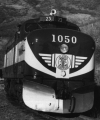 International Railway Car & Equipment Manufacturing Co
version International Railway Car & Equipment Manufacturing Co
version(photo: Mac's Foto Service) |
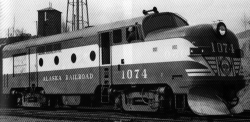 Puget Sound Bridge & Dredging Co version Puget Sound Bridge & Dredging Co version |
Two pictures of Shrouded units, taken from Clint Chamberlins website
 ARR #1070. Photo by Joseph Testagrose ARR #1070. Photo by Joseph Testagrose |
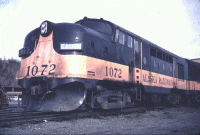 ARR #1072. Photo by Joseph Testagrose ARR #1072. Photo by Joseph Testagrose |
About half the programme was finished by January 1952, at which time the remaining locomotives were to be modified in the ARR shops at a rate of four or five a year. USA/TC 8001/43/51 were renumbered ARR 1021/12/1 respectively before being rebuilt into Nos 1069/77/5. Locomotives 8040/54 were rebuilt as streamline units for the ARR "Aurore" train. These were the first cab-booster set (1050-1051) to be covered in 1947 by the International Railway Car & Equipment Manufacturing Co. These locomotives retained their six-wheeled bogies for a while before being fitted with four-wheeled bogies. They were originally renumbered ARR 1050-A and 1051-A for a short period.
And the other units?
The remainder of the class were gradually put back into service of the USA/TC at various camps and depots in the United States. USA/TC 8037 was exhibited at the first annuel Armed Forces Day Exhibition at Washington DC, in 1950.
 USA/TC 8033 in the service of the US Air Force at EAFB, Florida, in June
1955 (Photo: H.L. Goldsmith)
USA/TC 8033 in the service of the US Air Force at EAFB, Florida, in June
1955 (Photo: H.L. Goldsmith)